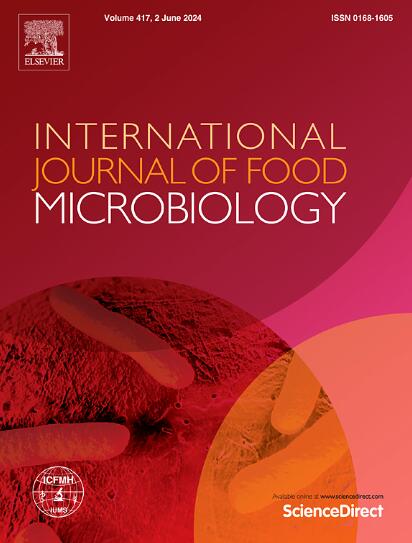Impact of pH and temperature in dairy processing on the infectivity of H5N1 avian influenza viruses
IF 5
1区 农林科学
Q1 FOOD SCIENCE & TECHNOLOGY
International journal of food microbiology
Pub Date : 2025-06-26
DOI:10.1016/j.ijfoodmicro.2025.111328
引用次数: 0
Abstract
Highly pathogenic avian influenza viruses of subtype H5N1 (clade 2.3.4.4b) can cause a mastitis-like disease in dairy cows. The presence of high amounts of infectious H5N1 virus in milk has raised significant concerns about the safety of raw milk products. In this study, the effect of temperature and pH on the stability of H5N1 viruses was investigated. We found that both bovine and avian H5N1 viruses remained infectious when incubated in milk at 4 °C for four weeks. When the viruses were incubated in milk at 21 °C, infectivity of avian H5N1 decreased only slightly and of bovine H5N1 moderately. The avian H5N1 virus was stable at 50 °C for 30 min but was inactivated at higher temperatures (55 °C for 10 min, 60 °C for 1 min, or 72 °C for 30 s). Bovine and avian H5N1 viruses were stable at pH levels between 6.0 and 10.0, but were partially inactivated at pH 5.0 and completely inactivated at pH 4.0. Both H5N1 viruses were completely inactivated when incubated with yoghurt at pH 4.2. Incubation of the avian H5N1 virus with soft and semi-hard cheese at pH 5.0–5.3 reduced infectious titers by 5.1 and 3.9 log10, respectively. In contrast, the infectivity of bovine H5N1 was only minimally reduced following incubation with semi-hard cheese. In conclusion, H5N1 viruses are efficiently inactivated by pasteurization and most thermisation procedures. However, in untreated raw milk bovine H5N1 virus may survive cheese-making processes if the production temperature stays below 50 °C.
乳品加工中pH和温度对H5N1禽流感病毒传染性的影响
H5N1亚型高致病性禽流感病毒(分支2.3.4.4b)可在奶牛中引起乳腺炎样疾病。牛奶中存在大量传染性H5N1病毒,引起了人们对原料奶制品安全性的严重关切。本研究探讨了温度和pH对H5N1病毒稳定性的影响。我们发现牛和禽H5N1病毒在4°C的牛奶中孵育4周后仍具有传染性。当病毒在21°C的牛奶中孵育时,禽H5N1的传染性仅略有下降,牛H5N1的传染性略有下降。禽流感H5N1病毒在50°C条件下稳定30分钟,但在更高温度下(55°C 10分钟、60°C 1分钟或72°C 30秒)灭活。牛和禽H5N1病毒在pH值为6.0 ~ 10.0时稳定,但在pH值为5.0时部分失活,在pH值为4.0时完全失活。两种H5N1病毒在pH为4.2的酸奶中孵育后均被完全灭活。用pH 5.0-5.3的软干酪和半硬干酪孵养H5N1禽流感病毒,可使感染滴度分别降低5.1和3.9 log10。相比之下,用半硬奶酪孵育后,牛H5N1的传染性仅略有降低。总之,H5N1病毒可通过巴氏灭菌和大多数热化程序有效灭活。然而,在未经处理的生牛乳中,如果生产温度保持在50°C以下,H5N1病毒可能在奶酪制作过程中存活。
本文章由计算机程序翻译,如有差异,请以英文原文为准。
求助全文
约1分钟内获得全文
求助全文
来源期刊
CiteScore
10.40
自引率
5.60%
发文量
322
审稿时长
65 days
期刊介绍:
The International Journal of Food Microbiology publishes papers dealing with all aspects of food microbiology. Articles must present information that is novel, has high impact and interest, and is of high scientific quality. They should provide scientific or technological advancement in the specific field of interest of the journal and enhance its strong international reputation. Preliminary or confirmatory results as well as contributions not strictly related to food microbiology will not be considered for publication.

 求助内容:
求助内容: 应助结果提醒方式:
应助结果提醒方式:


